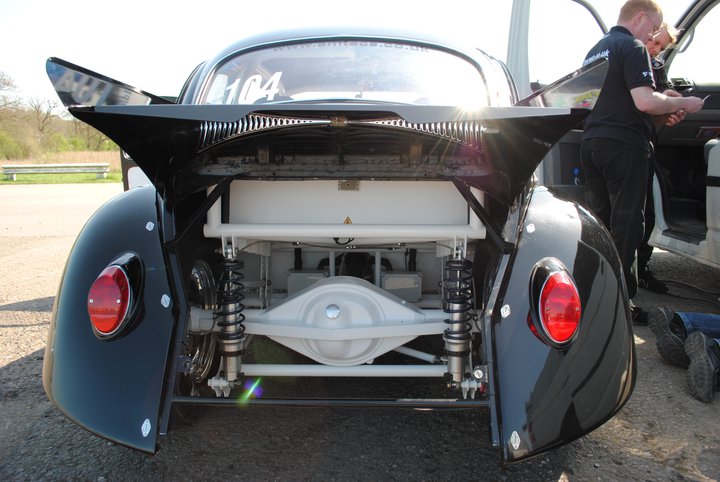Depending on who you speak to, electric power is either the death-knell for motor sport or the best thing since sliced bread
Racing cars, some people will tell you, need to make a noise. They simply must. And one must get oily while maintaining those cars, and worn-out parts will be replaced with regularity.
CHECK OUT: Cheapest MPG You Can Buy: What Cars Give You Lowest-Cost Mileage?
But a small sub-section of the racing community doesn't subscribe to that theory--electric cars could make racing cheaper, easier and indeed faster than conventional counterparts.
At the top end of the scale, this is already somewhat apparent.
Winning electric racers
Okay, so maybe not the "cheaper" aspect, but all the top endurance racing teams now field hybrid-electric vehicles in world-class events like the Le Mans 24 Hours. Entering a car without electric assistance is tantamount to failure.
Formula One racing has also gone down the hybrid route. Electric motors provide the cars with a 160-horsepower boost when required, as well as filling in the low-end torque gaps of the series' powerful turbocharged engines.
In motorcycling, electric racing is every bit as spectacular as combustion-powered racing, and very nearly as quick.
This year, Isle of Man Tourist Trophy legend John McGuinness averaged over 117 mph on an insane TT Zero lap of the infamous Snaefell Mountain Course--almost as quick as a 650cc class equivalent.
More pertinently, other TT Zero competitors had essentially built their bikes from scratch.
While they didn't quite match McGuinness's heady pace, all showed promise and all gained pace over the previous year's results far quicker than the regular gasoline motorcycles do. In motorcycling, electric power could be one of the quickest ways of putting amateurs on an even keel with factory teams.
Black Current III Electric Dragster
The same applies in drag racing. The potential here is greater than in any other motor sport, for new competitors to enter a powerful, home-built electric vehicle that sets competitive times.
Battery cost aside--and drag racers don't need huge batteries to do quarter-mile runs--it's certainly cheaper to buy a powerful electric motor than it is to tune a combustion engine to equivalent pace.
The famous Black Current electric Beetle, for example started out with the electric motor from one of Europe's once-common electric milk delivery vehicles. Hardly an expensive way to go racing, even if it only managed 21-second quarters.
ALSO SEE: Why Lithium-Ion Batteries Degrade With Repeated Charging
The team's latest car, Black Current III, uses a nine-inch Netgain Impluse motor. Specially built for the track it costs $10,000, but off-the-shelf you'll pay $1,500 for one. Okay, you'll not be leading your class with the basic motor, but there's quite a range between that 9.5-second quarter mile Beetle and cars in other classes.
Let's say your budget is lower, and you want to make a regular Beetle fast in a straight line. Or even around a track.
You could spend thousands getting your 40-horsepower Beetle to 80, maybe 100 horsepower. And then spend every weekend off tweaking and tuning the highly-strung, temperamental unit that results.
Alternatively, you could drop in an electric motor for an instant 100 horsepower. All you'd be spending then is a few pennies on electricity at each event, and maybe a few minutes polishing your car. And any resulting silverware...

EVSR electric race car in action (Image: Steve Kurey Photography via EVSR)
Circuit racing
Other series are also seeing the benefits. The Electric Vehicle Sports Racer is a prototype-style race car powered by electricity.
It already competes--and wins its class--in regional Sports Car Club of America (SCCA) events, and is quite capable of completing half-hour races on a charge.
There's no recalcitrant gearbox to deal with during the race, and Entropy Racing, the team that runs the car, extols the virtues of its quiet, clean, efficient running. And it's been painted bright yellow, so hardly lacks the visual impact spectators expect.
Electric power could certainly take some of the stress out of building a competitive car too. While motorsport is never cheap, reducing the chance of blowing up an engine or crunching through cogs in a gearbox removes a few of the typical racing issues.
As does the low cost of actually 'fueling' an electric racer, and filling it with oil and coolant. Leaving the hood open to let it cool down between runs is a thing of the past, too.
There will always be those who prefer racing with regular gasoline engines, and enjoy the noises, smells and feel of a traditional powerplant.
But for going quickly, and reducing the cost of racing, electric power now provides a compelling and entirely realistic alternative in many racing classes.
_________________________________________













